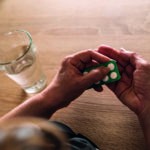Don’t panic when back pain strikes - there are many ways to alleviate the problem, as Michelle Higgs explains
In modern life, we do a lot of sitting down: at our desks while working on computers, when driving to and from work, and on the sofa watching TV. The human body was not designed to sit for hours on end, so it’s not surprising that this sedentary activity can lead to back pain.
Back pain is very common, especially in the lower back (known as lumbago). Sometimes it’s not clear what has caused the pain, but often it’s a result of a pulled muscle (strain) when moving awkwardly such as overstretching or twisting; it can also happen when lifting something heavy, sitting in the same position for too long, or suddenly doing much more physical activity than you normally do. The pain can be a dull ache, a stabbing sensation, or spasms that come and go in waves.
Around 8 million adults in the UK suffer with chronic pain, including back pain (British Pain Society)
Persistent minor pain or niggles in your back shouldn’t be ignored. They are a sign that something’s not quite right. At the same time, lower back pain is not usually serious and tends to settle down within a few weeks. Self-care in the early stages really helps to aid recovery so follow our tips for looking after your back.
Stay active
Your spine is strong, supporting your body and allowing you to move about, but is also flexible enough for you to bend. In previous decades, people were told to rest when they had backache. But this is now known to be incorrect; in fact, the spine needs movement to help it to recover from any issues. You should avoid spending long periods of time lying down as this is not likely to make the pain better and could even do the opposite. Instead, stay active and try to continue with your day-to-day routine. In particular, physical activities such as swimming, cycling, walking, Pilates and yoga can help reduce the pain levels.

Improve your posture
Getting your posture right is vital to avoid back pain and to ease it as you recover. Your spine has a natural ‘S’ shape and in this position, your body is balanced with your weight and gravity evenly distributed. When sitting, the aim is to maintain the ‘S’ shape. You can do this by sitting up straight and consciously not slouching. This is particularly important when sitting at a desk. The chair should be adjustable and supportive with a backrest. Make sure you sit back in the chair, not on the edge, and move it closer to the desk to avoid overstretching. If the chair does not have lumbar support, placing a small rolled-up towel at the bottom of your back will have a similar effect.
Strengthen your back
Like any muscle, the ones in your back need to be exercised regularly to strengthen and support them. Start with gentle stretches that target your core muscles. There is an excellent video on the NHS website showing simple stretches for your back that are easy to build into your daily routine (https://www.nhs.uk/conditions/back-pain/). There are also plenty of other free videos online. If your back pain gets worse while doing these exercises, you should visit your local pharmacy or see your GP for further advice.
You could also add physical activities to your regular exercise that are particularly good for strengthening your back. These include walking, swimming and cycling. Consider taking classes in yoga and Pilates as they can be very beneficial for your back and will help to improve your balance and posture. Although there are videos online, it’s worth going to a course of classes first to ensure you’re positioning your body correctly.
Maintain a healthy weight
If you’re very overweight or obese, carrying those extra pounds will put a great deal of pressure on your joints and muscles, leading to various aches and pains including backache. In fact, excess fat, especially in the abdominal area, puts your spine out of balance and pulls the curve of the lower back forward.
The solution is to gradually lose weight by eating a healthy, balanced diet and exercising more where possible. Not only will your backache be eased, your whole body will thank you for it! Visit the NHS Eat Well website for advice about healthy eating (https://www.nhs.uk/live-well/eat-well/). If you’re obese, check with your GP or local pharmacy before starting any new physical activities. It’s important to build up your fitness levels slowly – doing too much, too quickly, could cause an injury.
Use pain relief
When you have back pain you don’t have to just grin and bear it. Pharmacological intervention is possible. Speak to your local pharmacist to determine the best ones for you.
Check with your local pharmacy if you’re unsure what kind of over-the-counter medication you should be taking.
You can also get some temporary relief for backache by using a hot water bottle to relieve stiffness and spasms, and a bag of frozen peas wrapped in a tea towel to reduce pain and swelling. Heat and ice packs can also be bought from your pharmacy.
Back pain is the largest single cause of disability in the UK (National Low Back Pain and Radicular Pain Pathway)
5 ways to avoid back pain
1 Before lifting anything, keep your back straight and bend your hips and knees; lift the object by straightening your legs.
2 When sitting at a desk, stand up and take regular breaks as often as possible throughout the day and walk about for a minute or two.
3 Try a standing desk, instead of a traditional sitting desk, if you’re struggling with stiffness and pain in your back.
4 Change your mattress or whole bed if it’s more than 8 to 10 years old and it’s no longer comfortable.
5 Reduce any tension in your back by using relaxation techniques such as breathing, meditation and mindfulness.
How your local pharmacy can help
If you have sudden back pain, your first thought may be to visit your GP. But unless the pain is severe and it’s stopping you from sleeping and doing your day-to-day activities, you can get all the help you need from your local pharmacy. As a qualified medical professional, the pharmacist will ask you about your symptoms, how long you’ve had them for, and the level of pain you’re experiencing. They can offer advice about which painkillers are best for you and the kind of exercises and stretches that might help you. They may also suggest some topical pain relief gel that can be rubbed into the affected area of your back.
There are a few more serious conditions that cause back pain, including sciatica (trapped nerve), a slipped disc, and ankylosing spondylitis. The pharmacist can also refer you to your GP if they believe a medical investigation is needed.














![BODi-NPA_UK-MPU_Hero-1300×450[14]](jpg/bodi-npa_uk-mpu_hero-1300x45014-1-150x150.jpg)






























































































![19150_Diageo NCP MPU Hero_1300x450px[94][42]](png/19150_diageo-ncp-mpu-hero_1300x450px9442-150x150.png)














